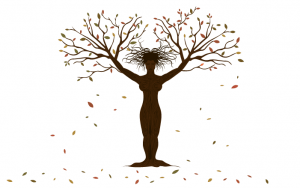Let me say, I am sitting outside as I type this, and 61 degrees feels so great. Anyways, in this week’s blog, I want to discuss the interconnected web of ecofeminism.
I believe it is only appropriate to define intersectionality for those who may be confused or don’t know what it truly means. Intersectionality is a way of connecting social categories of people or nature and it typically results in some sort of discrimination when people are placed into these different categories. This web or frame could include one’s race, gender, class, etc. Feminists have taken this intersectionality web from it being primarily for “the experience of black women” (Kings 2) and are now using it to examine differences and oppression amongst all women. Ecofeminists, in contrast, are “concerned with understanding the interconnected relationship between the domination of women and the domination of nature” (Kings 16). This makes sense because of the name ECO-Feminists. Within this web, different forms of oppression collide and connect with one another and that is why it could be called a web. As we know from previous readings both women and nature experience oppression and ecofeminists want to view and understand the connections between the two on this web that lead to the oppression. For example, back to the Global South. If something happens and say river water or a water source for families becomes polluted, women now face oppression because they are not able to provide clean and safe water for their family. To also understand why women and nature are oppressed and the connections amongst things, ecofeminists look at class and location. Rather those women are poor, whether they live in the Global South versus the North.
Now taken from another article, some argue that even ecofeminism lacks intersectionality and only focuses on the treatment of white and middle-class people. A need for a movement for black women who face oppression from some of the same environmental problems is needed in order to complete this web of connections between women’s and nature’s oppression. In an ecofeminist web, race should have connections with women and nature and oppression. Without including black women or women of color in this web, we are back to what feels like a hierarchy. Where one’s oppression is more than another’s, or one’s problems come before someone else. That goes against feminism in general. Women are supposed to stick up for each other no matter their race, age, etc.
Now I want to talk about the importance of ecology when it comes to the ecofeminist web of connectivity. In order to disprove a hierarchy, one must start with the nonhuman things. Taken from the class notes “ecofeminist theory seeks to show the connections between all forms of domination, including the domination of nonhuman nature, and ecofeminist practice is necessarily antihierarchical.” Ecology has been said to be a feminist issue. Amongst ecosystems comes another connected web and then those things are connected to humans, specifically women who face some of the same oppressions as nature and ecosystems. Ecofeminists must start with the roots of nature and then connect those to the roots of women to then understand how the connections lead to the oppression of both.



Thank you for highlighting the fact that woman’s rights are looked at from a perspective of white woman in society. I am curious if the movement truly caters to white woman, would black woman be able to start their own movement for black women’s rights without a cry of racism? In a previous class that I had taken, there was a popular hat worn around in support of woman’s rights. It resembled pink genitalia. It was supposed to be in support but left out black woman or transgender woman that may not relate physically. I do feel as if white woman slip under the radar with this one sided viewpoint. Also, what about how transgender woman are also not considered to have the same oppressions as woman and are disregarded.
I’ve known what intersectionality means for a while but after this week’s readings I really see why it is compared to a web. Like in a spider’s web each strand comes together and intersects, some are connected, some cross paths, yet they all make up a whole product. Just as all the identities in which a human can identify as, they all connect together to create intersectionality. As you said all these different identities face discrimination, or oppression. Not only that they are often all dominated by some other identity. Most identities we read about this week, gender, race,sexual orientation and even nature are all dominated by the patriarchal system. In this week’s readings we saw a lack of acknowledgment regarding environmental degradation/racism and black women. I believe this is a perfect example as to why from an ecofeminist perspective it is important to analyze the oppressions faced not just by women as a whole, (because they will often only observe middle/high class white women) but also women of color, women who are lesbians, women who come from a poorer class, and women who have disabilities. It is unfortunate but true that the oppression of women with these certain identities are often left in the dark. Yet as we have read in the past these women are more than not the ones who are facing the most problems regarding environmental degradation. As you explained nature is being dominated by men, they are tearing down trees to build different infrastructures, leading to degraded soil which leads to water being tainted with pesticides and other harmful chemicals. It is like an ongoing chain that leads to the oppression of women because with all this degradation it makes it a lot harder for women, particularly in the Global South, to keep themselves and their families healthy. Since they are the ones who are expected to care for their families, if they are not able to provde for their families, they will face even more oppression and potential scolding from the men of the households. It is important we focus on intersectionality in feminism in order to try to stop the oppression of not only women of different identities, but of the environment as well!
Hi Ashton! I too enjoyed that nice warm weather from earlier in the week. I first wanted to point out that I appreciate that you gave us a definition of what intersectionality means. It helps the reader to identify the topic of interest in your post and then is able to better understand it. I also particularly like this quote from you, “This web or frame could include one’s race, gender, class, etc. Feminists have taken this intersectionality web from it being primarily for “the experience of black women” (Kings 2) and are now using it to examine differences and oppression amongst all women. Ecofeminists, in contrast, are “concerned with understanding the interconnected relationship between the domination of women and the domination of nature”. This point you made is very informative and shows that you understand the topic, and I do like that you described ecofeminist intersectionality as pertaining to race, gender, class, etc. Women of color, different ethnic backgrounds, different sexualities, and of disabilities are often forgotten and therefore are oppressed. In order to fully understand the connectivity of women and nature, we must include all women, not just the ones we see on TV. That is when we will truly be able to understand the intersectionality web. Lastly, when you talked about the ecology aspect of the ecofeminist web of connectivity, all I could think of was the circle of life. There is no waste in the ecological system, every creatures’ remains play a part in another species’ life. However, this does not pertain to us, humans. Our remains and waste stay on this planet forever and do not contribute to any other ecology system. The circle of life itself could be its own connectivity web between all humans and nature. Overall, great post this week, looking forward to the next one!
I really acknowledge the way you start your blog. Your explanation of intersectionality will make readers best understand the concept behind it and how ecofeminists connect it. Discrimination is all over the world. It’s based on race, age, gender, caste, religion etc. The most common that we often hear is discriminating based on race, that is, white over colored. But what about others? They do exist, but sometimes most of us ignore it when happen in day to day life. We categorize people according to their age and then we decide which age group is best and which is not. You might have seen in school that elder students make fun of youngers and bully them. Thank God I was never bullied by anyone but yeah, I have heard so much from my elders and that too 3-5 years elder than me only saying “You are too young”. Am I?
I was watching a show by name 100 Humans, one of the episodes I saw was based on age differentiation. They divided 100 humans into age groups and gave them similar task to determine which age group is more efficient. This might not seem wrong, but it still is discrimination. Female and male, is never ending debate. Caste system can be best explained by Indian culture. Higher to lower rank of caste are; Brahmin (Priest), Kshatriya (Warriors, Kings), Vaishya (Merchants, landowners), Sudra (commoners, peasant, servants). People in India are ranked under this category of caste and inter-caste marriages aren’t acceptable. I went in greater detail, but coming back to intersectionality in ecofeminism, it is seen that although feminists’ goal is to get equal rights for women which includes all women regardless of any differences, but yet intersectionality exists. Asian American women vs white women. Shruti Mukkamala and Karen L. Suyemoto in their article “From Exotic to Invisible: Asian American Womens’ Experiences of Discrimination” conducted a study of 107 participants and asked about their experiences of any kind of discrimination. Only four said that they never experienced discrimination. They wrote six themes that described participants experiences which includes; exotic, not a leader, submissive, cute and small, invisible and service worker. The detail of each can be obtained from the link provided bellow. They also mentioned other types of discrimination that you can check on the link bellow.
https://www.apa.org/pubs/highlights/spotlight/issue-119
Ecology and feminism are linked. We are studying from the beginning that feminism is part of ecology and ecology is part of feminism. Hence, ecofeminism. We know that women and nature are oppressed. And women are the ones who get most effected by environmental degradation. Because women are responsible for so many things, they tend to feel more when it comes to environmental degradation. So, there’s not only connection between humans but we humans are connected with non-humans too.
For some reason while reading this I believe you should do some more research on black lives matter just by the way you types this up, it was a nice read and comforting. Thought I think we should face the facts in this day an age we still see racism when it comes to whites/blacks. Have you noticed that women with 4c hair always made fun of about their hair? Isn’t quite funny that when trees/bushes and plants of the earth grow it kind of resembles 4c hair? So think about it black women have that connection with nature. I see black women and nature as the same.